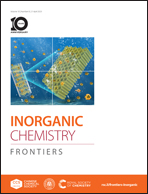Porphyrinic metal–organic frameworks as molybdenum adsorbents for the 99Mo/99mTc generator†
Abstract
Two porphyrinic metal–organic frameworks (PCN-222 and PCN-224) were prepared and their potential as molybdenum adsorbents for the 99Mo/99mTc generator was explored. The molybdenum adsorption properties of the two adsorbents, including adsorption kinetics and equilibrium isotherms, were evaluated at different molybdenum concentrations and pH. The maximum adsorption capacity of PCN-222 and PCN-224 was evaluated to be 525 mg g−1 and 455 mg g−1, respectively. The possible adsorption mechanism was investigated by X-ray Photoelectron Spectra and Fourier-Transform Infrared Spectroscopy. The results demonstrated that molybdenum species were adsorbed on the two MOFs through electrostatic attraction and hydrogen bonds. In the case of PCN-222, the Mo–O–Zr coordination interaction also played an important role. Additionally, the elution performance of two 99Mo/99mTc generators developed by using PCN-222 and PCN-224 as adsorbents was measured to assess possible clinical applications. The PCN-222-based 99Mo/99mTc generator exhibited better elution performance and showed that around 56% of 99mTc could be obtained without zirconium breakthrough when relatively high pH solutions were used (pH = 9.6).



 Please wait while we load your content...
Please wait while we load your content...